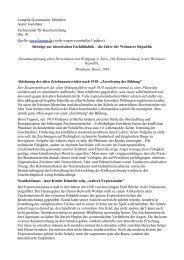Research in Visual Arts Education - The National Society for ...
Research in Visual Arts Education - The National Society for ...
Research in Visual Arts Education - The National Society for ...
You also want an ePaper? Increase the reach of your titles
YUMPU automatically turns print PDFs into web optimized ePapers that Google loves.
ISSUES IN VISUAL ARTS EDUCATION<br />
<strong>The</strong> conceptual framework (Miles & Huberman, 1994, pp. 18-22) displayed<br />
<strong>in</strong> Figure 2, is not <strong>in</strong>tended to be complete, to summarize a specific Nordic<br />
perspective, or to propagate a particular philosophy. Below, <strong>in</strong> exemplify<strong>in</strong>g<br />
the concepts chosen, there is a bias towards Swedish and American studies,<br />
i.e. those bodies of research with which I am most acqua<strong>in</strong>ted. <strong>Research</strong>ers<br />
with another <strong>in</strong>tellectual background would probably have organized the<br />
knowledge base differently. However, regardless of whether one f<strong>in</strong>ds the<br />
design of this map useful or not, it may stimulate the reader to articulate his<br />
or her own preferred way to understand the knowledge resources of visual<br />
arts education. Indeed, the framework should be thought of as a dynamic<br />
structure, which can be elaborated <strong>in</strong> many directions <strong>for</strong> multiple purposes.<br />
<strong>Arts</strong> education policy<br />
<strong>Arts</strong> education policy occupies a central position <strong>in</strong> the map and is a natural<br />
start<strong>in</strong>g po<strong>in</strong>t as we move clockwise around the core of visual arts education.<br />
Policy documents usually relate what happens <strong>in</strong> school to a wider<br />
arena of cultural and educational policies, l<strong>in</strong>k<strong>in</strong>g art education to democracy,<br />
multiculturalism, creative and critical th<strong>in</strong>k<strong>in</strong>g, etc. In the Swedish<br />
national curriculum (Skolverket, 2000), <strong>for</strong> example, visual arts education is<br />
explicitly l<strong>in</strong>ked to civil rights:<br />
Knowledge about pictures and visual communication are important conditions <strong>for</strong> an<br />
active participation <strong>in</strong> the social life. An advanced capacity to make pictures facilitates <strong>for</strong><br />
children and youth to exercise their cultural freedom of speech, which <strong>in</strong>cludes the right<br />
to <strong>for</strong>mulate op<strong>in</strong>ions of one’s own as well as hav<strong>in</strong>g an <strong>in</strong>fluence. <strong>The</strong> school supports<br />
the right of children and adolescents to be full participants <strong>in</strong> the art world and cultural<br />
life, and warrants them, together with the society’s cultural life with<strong>in</strong> and outside its<br />
<strong>in</strong>stitutions, the right to multiple <strong>for</strong>ms of expression (p. 8).<br />
In the Norwegian national curriculum, the field of art and design education<br />
<strong>in</strong> the compulsory school is l<strong>in</strong>ked to the idea of democratic participation<br />
<strong>in</strong> develop<strong>in</strong>g the local environment. Participation assumes skills and knowledge<br />
s<strong>in</strong>ce decisions are often made on the bases of pictorial representations,<br />
such as architectural draw<strong>in</strong>gs (Nielsen & Digranes, 2007).<br />
Child and youth study<br />
Child and youth study has deep roots <strong>in</strong> the field of art education. From<br />
about 1885 to the 1960s <strong>in</strong>terest ma<strong>in</strong>ly focused on children’s draw<strong>in</strong>gs.<br />
Until the 1920s, many attempts were made to classify children’s draw<strong>in</strong>gs<br />
18 NORDIC VISUAL ARTS EDUCATION IN TRANSITION



